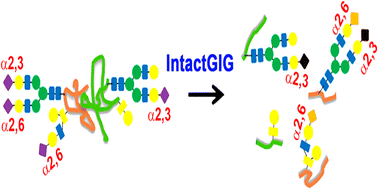Identification of Sialic Acid Linkages on Intact Glycopeptides via Differential Chemical Modification Using IntactGIG-HILIC |
| |
| Authors: | Shuang Yang Wells W Wu Rong-Fong Shen Marshall Bern John Cipollo |
| |
| Institution: | 1.Laboratory of Bacterial Polysaccharides, Division of Bacterial, Parasitic and Allergenic Products,Center for Biologics Evaluation and Research, Food and Drug Administration,Silver Spring,USA;2.Facility for Biotechnology Resources,Center for Biologics Evaluation and Research, Food and Drug Administration,Silver Spring,USA;3.Protein Metrics Inc.,San Carlos,USA;4.Laboratory of Bacterial Polysaccharides, Division of Bacterial, Parasitic and Allergenic Products,Center for Biologics Evaluation and Research, Food and Drug Administration,Silver Spring,USA |
| |
| Abstract: | Mass spectrometric analysis of intact glycopeptides can reveal detailed information about glycosite, glycan structural features, and their heterogeneity. Sialyl glycopeptides can be positively, negatively, or neutrally charged depending on pH of their buffer solution and ionization conditions. To detect sialoglycopeptides, a negative-ion mode mass spectrometry may be applied with a minimal loss of sialic acids, although the positively charged or neutral glycopeptides may be excluded. Alternatively, the sialyl glycopeptides can be identified using positive-ion mode analysis by doping a high concentration of sodium salts to the analytes. Although manipulation of unmodified sialoglycopeptides can be useful for analysis of samples, less than optimal ionization, facile loss of sialyl and unfavorable ionization of accompanying non-sialyl peptides make such strategies suboptimal. Currently available chemical derivatization methods, while stabilizing for sialic acid, mask sialic acid linkage configuration. Here, we report the development of a novel approach to neutralize sialic acids via sequentially chemical modification that also reveals their linkage configuration, often an important determinant in biological function. This method utilizes several components to facilitate glycopeptide identification. These include the following: solid phase derivatization, enhanced ionization of sialoglycopeptides, differentiation of sialic acid linkage, and enrichment of the modified glycopeptides by hydrophilic interaction liquid chromatography. This technology can be used as a tool for quantitative analysis of protein sialylation in diseases with determination of sialic acid linkage configuration. |
| |
| Keywords: | |
| 本文献已被 SpringerLink 等数据库收录! |
|

